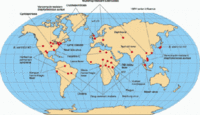-
New view of dengue fever

Dengue fever is a mosquito-borne illness that infects at least fifty million people worldwide each year. This infectious tropical disease is found in more than 100 countries, and it has no cure and no vaccine. One reason why it has been difficult to develop new drugs for dengue fever is that there are no good animal models of the disease, which only infects humans. Researchers have now produced a “humanized mouse” that mimics many features of the human immune system. These mice with human immune cells help researchers discover how the mosquito-borne virus depletes blood platelets.
-
-
Risks of SARS, MERS spreading greater than thought: scientists
Outbreaks such as the severe acute respiratory syndrome (SARS) and Middle East respiratory syndrome coronavirus (MERS) have afflicted people around the world, yet many people think these trends are on the decline. Quite the opposite is true. Scientists discovered that the genetic diversity of a viral population within a host animal could allow a virus to adapt to certain conditions, which could help it reach a human host.
-
-
Scientists develop safe method for research on deadly flu viruses

In 2012, scientists around the world agreed to a worldwide, yearlong voluntary moratorium on research into the deadly H5N1 bird flu. The ban came after several scientific teams successfully altered the H5N1 viral genome to enable airborne transmission of the bird flu between ferrets — mammals considered a good research model for humans. The public health concern was that altered H5N1 could escape the lab, infect and spread among humans, producing a global pandemic. There was also concern that terrorists would use the altered H5N1 viral genome in large-scale bioterror attacks. Researchers have now been able to turn molecules in human lung cells into viral scissors that cut H5N1 bird flu and similar bugs into pieces. This dismantling of the viral genome in human lung cells will ensure safe research on deadly strains of influenza.
-
-
CDC: Action needed now to halt spread of deadly, antibiotics-resistant bacteria
Data show more inpatients suffering infections from bacteria resistant to all or nearly all antibiotics. CDC says that the findings are a call to action for the entire health care community to work urgently — individually, regionally, and nationally — to protect patients. During just the first half of 2012, almost 200 hospitals and long-term acute care facilities treated at least one patient infected with these bacteria.
-
-
Superbug crisis shows progress in antibiotic development “alarmingly elusive”
Despite the desperate need for new antibiotics to combat increasingly deadly resistant bacteria, the U.S. Food and Drug Administration (FDA) has approved only one new systemic antibiotic since the Infectious Diseases Society of America (IDSA) launched its 10 x ’20 Initiative in 2010 — and that drug was approved two and a half years ago.The IDSA says that time is running out for meeting the IDSA Goal of ten new antibiotics by 2020.
-
-
CDC warns of parasites-related illnesses in fifteen states
The Center for Disease Control and Prevention (CDC) announced on Monday that the number of Cyclospora cases has risen to 373 in fifteen states. State and federal health officials have not named the food or water source responsible for to the outbreak, but fresh produce is the likely source.
-
-
New malaria test kit would help global elimination efforts

A new, highly sensitive blood test that quickly detects even the lowest levels of malaria parasites in the body could make a dramatic difference in efforts to tackle the disease in the United Kingdom and across the world, according to new research.
-
-
Bird flu in live poultry markets source of viruses causing human infections

Following analysis of H7N9 influenza viruses collected from live poultry markets in China, it was found that these viruses circulating among birds were responsible for human infections. These results provide a basis for the government to take actions for controlling this public health threat.
-
-
Ebola's secret weapon revealed: its ability to short-circuit the immune system
Researchers have discovered the mechanism behind one of the Ebola virus’ most dangerous attributes: its ability to disarm the adaptive immune system. Scientists determined that Ebola short-circuits the immune system using proteins that work together to shut down cellular signaling related to interferon. Disruption of this activity, the researchers found, allows Ebola to prevent the full development of dendritic cells that would otherwise trigger an immune response to the virus.
-
-
Mankind is still at risk of the plague

The plague has affected global population levels, with around seventy-five million people perishing during the fourteenth century’s Black Death. A new study finds that a number of factors show we are still at risk of plague today. The study also provides lessons for how best to control the plague.
-
-
Malaria infection risk influenced by daily variations in temperature
Identifying areas of malarial infection risk depends more on daily temperature variation than on the average monthly temperatures, according to researchers, who believe that their results may also apply to environmentally temperature-dependent organisms other than the malaria parasite.
-
-
Third U.K. coronavirus infection suggests person-to-person transmission
A third person has contracted the new coronavirus and is being treated in an isolation room of the Queen Elizabeth Hospital in Birmingham and is in stable condition. Worldwide, there have been eleven cases diagnosed, and the disease has killed almost half of them. According to medical experts, the new strain was detected three months ago and this is the first time it has been known to pass between people, which suggest it may not be particularly infectious.
-
-
Improving mapping of infectious disease

Since the mid-nineteenth century, maps have helped elucidate the deadly mysteries of diseases like cholera and yellow fever. Yet today’s global mapping of infectious diseases is considerably unreliable and may do little to inform the control of potential outbreaks, according to a new systematic mapping review of all clinically important infectious diseases known to humans. The study recommends new tools to improve global mapping of infectious disease.
-
-
Technique used to nab serial killers helps in controlling pests and disease and in counter-terrorism

A technique designed to help criminologists catch serial killers is being used by scientists to locate sources of disease, control pests, and study animal behavior; locating a serial killer’s home is similar to finding the nests of animals or centers of disease outbreaks; ecological approaches have applications in counter-terrorism work, as terrorist cells tend to have more than one anchor point within the area in which they operate, exactly so they can avoid detection
-
-
Social media as preventative method for infectious diseases
When it comes to stopping illness, social media posts and tweets may be just what the doctor ordered; researchers are studying whether a well-timed post from a public authority or trustworthy person could be as beneficial as flu shots, hand-washing, or sneezing into an elbow
-
- All
- Regional
- Water
- Biometrics
- Borders/Immig
- Business
- Cybersecurity
- Detection
- Disasters
- Government
- Infrastructure
- International
- Public health
- Public Safety
- Communication interoperabillity
- Emergency services
- Emergency medical services
- Fire
- First response
- IEDs
- Law Enforcement
- Law Enforcement Technology
- Military technology
- Nonlethal weapons
- Nuclear weapons
- Personal protection equipment
- Police
- Notification /alert systems
- Situational awareness
- Weapons systems
- Sci-Tech
- Sector Reports
- Surveillance
- Transportation
Advertising & Marketing: advertise@newswirepubs.com
Editorial: editor@newswirepubs.com
General: info@newswirepubs.com
2010-2011 © News Wire Publications, LLC News Wire Publications, LLC
220 Old Country Road | Suite 200 | Mineola | New York | 11501
Permissions and Policies
Editorial: editor@newswirepubs.com
General: info@newswirepubs.com
2010-2011 © News Wire Publications, LLC News Wire Publications, LLC
220 Old Country Road | Suite 200 | Mineola | New York | 11501
Permissions and Policies
